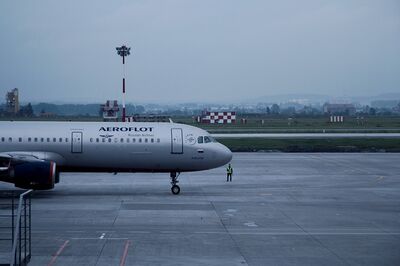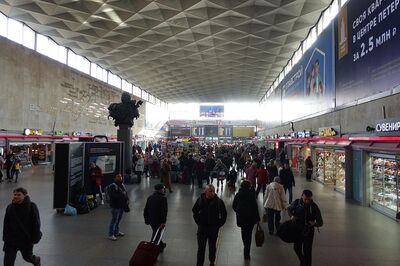
The Easiest, Fastest and Safest Way to Buy Sapsan Tickets
Due to the current situation, we are temporarily unable to issue tickets.
Sorry for the inconvenience.
St. Petersburg to Moscow - Sapsan Train Route
What is the Sapsan Train Schedule for the St. Petersburg to Moscow Route?
- There are more than 12 departures per day
- The earliest departure is at 05.45
- The latest departure is at 21:00
- There are a different number of stops for each departure
- Trip duration is 3.5-4 hours
All St. Petersburg to Moscow Sapsan trains depart from Moskovsky Railway Station at 85 Nevsky Prospect. The station is easily accessible by all forms of public transportation and is only steps away from the metro station Ploshchad Vosstaniya. There are more than 12 Sapsan departures from St. Petersburg to Moscow every day, starting as early as 5:30 am. The normal travel time between the two cities is about four hours, but at certain times of day, it can take as little as three and a half.
Aboard all Sapsan St. Petersburg to Moscow trains, there are multiple seating options which differ in price and included amenities. Food is available on all trains and with certain seating classes is included with the purchase of your ticket. Along the route from St. Petersburg to Moscow, you can look out your window to see beautiful scenery as you pass through towns such as Chudovo, Uglovka, and Tver. Please refer to the Sapsan St. Petersburg to Moscow route map below.
St. Petersburg to Moscow Sapsan Train Schedule
| Train No | St. Petersburg | Chudovo | Okulovka | Uglovka | Bologoe | Vyshny Volochyok | Tver | Moscow |
|---|---|---|---|---|---|---|---|---|
| 751 (daily) | 5:30 | 9:00 | ||||||
| 753 (daily) | 6:40 | 7:25 | 8:07 | 8:17 | 8:52 | 9:34 | 10:43 | |
| 755 (daily) | 6:50 | 8:46 | 9:44 | 10:52 | ||||
| 757 (daily) | 9:00 | 10:52 | 11:49 | 12:58 | ||||
| 759 (daily) | 9:10 | 10:39 | 10:50 | 11:25 | 13:05 | |||
| 761 (Sat, Sun) | 11:00 | 12:30 | 13:41 | 14:46 | ||||
| 763 (Sat, Sun) | 11:10 | 11:56 | 13:00 | 14:56 | ||||
| 765 (daily) | 13:00 | 14:52 | 15:49 | 16:58 | ||||
| 767 (daily) | 15:00 | 16:22 | 17:03 | 18:45 | ||||
| 769 (daily) | 15:10 | 15:56 | 17:55 | 18:59 | ||||
| 771 (daily) | 17:00 | 18:24 | 19:41 | 20:57 | ||||
| 773 (daily) | 17:10 | 17:55 | 18:42 | 19:01 | 21:02 | |||
| 775 (daily) | 19:00 | 20:51 | 21:48 | 22:58 | ||||
| 777 (daily) | 19:10 | 19:59 | 20:41 | 20:51 | 21:27 | 22:09 | 23:13 | |
| 779 (daily) | 21:00 | 23:33 | 0:35 |
Sapsan St. Petersburg to Moscow Train Tickets
★★★★★★★★☆☆ 8.8 based on 291 customer reviews
Welcome on Board and Enjoy the Ride!
Once you have your tickets, look forward to a wonderful, smooth and quick journey on Russia’s and one of the world’s most modern, fast and cutting edge trains - The Sapsan. Buy your ticket safely and securely and then sit back and enjoy the ride!
Frequently Asked Questions From Our Travelers
In St Petersburg, the Sapsan departs from the Moskovsky Train Station, Nevsky Prospect 85, Metro station Ploshad Vosstania.
In Moscow, all Sapsan trains running between St Petersburg and Moscow arrive at the Leningradsky Train Station, located at Komsomolskaya Ploshad 3, Metro Komsomolskaya.
We highly recommend that you buy Sapsan tickets well in advance, as soon as they are available for purchase, usually 90 days before the trip. The tickets sell out very quickly and the later you buy tickets, the more expensive they become due to the dynamic pricing policy of the Russian Railroad.
Tickets for the Sapsan are available 90 days prior to departure.
Though the flight time from St Petersburg to Moscow is 1.5 hours while the Sapsan travel time is approximately 4 hours, traveling by a high speed Sapsan train is considered to be the most convenient and fastest way to travel from St Petersburg to Moscow. Train stations in both cities are in the city center so the travel time is significantly shorter when compared to traveling by plane which includes airport check-in and traveling to and from the airport.
The St. Petersburg to Moscow Railway – A History
In Russia, a tradition of naming train stations for the largest city that the line passes through exists. When leaving St. Peterburg to go to Moscow, the Moskovsky station sends trains to Moscow. Upon arrival, you’ll see that you’ve reached a large, grand station called Leningradsky. Venture out into what is known as Three Station Square, and you’ll see that this square’s nickname holds true. Yaroslavsky and Kazansky stations also sit on this square.
Now that Sapsan trains make this journey in under four hours, passengers disembarking in Moscow have more remaining energy to take in the other stations and explore the square. Each station has an interesting façade and a clock tower. All three were constructed in the middle of the 1800’s. One would think that they would resemble each other more, however the styles differ. Leningradsky is the most impressive and imposing of the three. In the center sits a golden statue of the original minister who built the railways.
With the transition to the USSR after imperial rule, St. Petersburg became known as “Lenin’s City”, or Leningrad. The train station retains its name Leningradsky Station, although St. Petersburg has returned to its nominal roots, which pay homage to Peter the Great. In the same vein, the railway between Russia’s two great cities of the west retained its name, “Oktyabrskaya.” The first name had been “Nikolskoye,” in honor of the Tsar. This line carries an impressive 140 million passengers each year.
An Imperial Launch
At the time that Russia considered building railroads as other progressive nations did so, cargo ships were the main transporters of goods between St. Petersburg and Moscow. Yet Britain’s railways were already chugging along, inspiring other nations. Nikolai I was approached by a German businessman named Franz Gerstner, who wanted to secure a contract to build a railroad. He hoped it would go from St. Petersburg to Moscow and on to Nizhny Novgorod. Nikolai went as far as setting up a commission on the topic.
The Russian leadership debated for months. However, the commission thought the plan too intricate and large. Also, Franz’s proposal was deemed too self-serving, as he’d requested a monopoly on the construction of Russian railroads for the next twenty years. Franz built only a 27km rail line to Trasroye Selo. This town had an imperial country residence and was a literary enclave. This short track was finished in 1837.
Although Nikolai sent an engineer to study American rail systems, his subsequent proposal for a longer rail line didn’t pass the commission’s discriminating standards either. At a cost of 43 million roubles, the commission wouldn’t budge, even if 37km/h did seem like an appetizing speed. The commission recommended new tracks for carriages instead, thereby playing it safe and familiar. However, the emperor proved ready for progress and speed. In 1842, the government bureaucrats found themselves bypassed when the St. Petersburg to Moscow railroad was commissioned by the Tsar. The track would be 644 km.
A Rocky Start
After a decade of grueling construction that claimed lives and limbs, the railway was nearly complete. It was time for it to be tested by the Tsar and his entourage. They hoped for a thrilling yet smooth journey from St. Peterburg to Moscow on this new railroad. It was the fall of 1851.
A few hasty arrangements were made to try to distract the entourage from problems with the new railway. “Gardens” of a not-so-permanent sort were placed where the train would pause. Workers in spiffy uniforms walked about, hoping to draw the eye of the passengers away from shortcomings. Soldiers were also stationed along the line for safety. In the end, the emperor did not disapprove of the rail line.
However, the first batches of passengers on the train didn’t enjoy as pleasant of a ride. Without heating or toilets, comfort was almost out the door. Babushkas had yet to arrive to offer pies on the long journey. The train could pause on the tracks for up to twelve hours to be repaired. On an already twenty-two-hour voyage without heat, this was not just inconvenient, but dangerous. Passengers on the former "Nikolskoye” line would wade through the snow to nearby towns in hopes of preventing frostbite. Three classes of tickets were offered. However, the first-class experience in the signature blue carriages seemed to only provide an upgrade to thicker seat cushions.
A small part of the tracks received attention from a single steam-excavation machine. Human labor built the remaining tracks, which totaled more than 600 kilometers.
Continual Progress
The travel time, reliability and train carriage features made significant progress over the next decades. Today, the Oktyabrskaya railway only carries passengers, and Sapsan trains bring them from St. Petersburg to Moscow in as little as three and a half hours.









